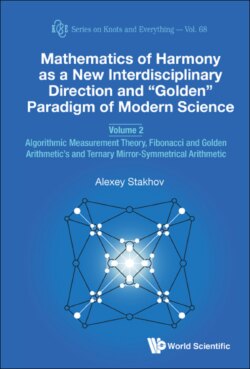Читать книгу Mathematics of Harmony as a New Interdisciplinary Direction and “Golden” Paradigm of Modern Science - Alexey Stakhov - Страница 6
ОглавлениеContents
Preface to the Three-Volume Book
Chapter 1. Foundations of the Constructive (Algorithmic) Measurement Theory
1.1 The Evolution of the Concept of “Measurement” in Mathematics
1.2 Axioms of Eudoxus–Archimedes and Cantor
1.3 The Problem of Infinity in Mathematics
1.4 Criticism of the Cantor Theory of Infinite Sets
1.5 Constructive Approach to the Creation of the Mathematical Measurement Theory
1.6 The “Indicatory” Model of Measurement
1.7 The Concept of the Optimal Measurement Algorithm
1.8 Classical Measurement Algorithms
1.9 Optimal (n, k, 0)-Algorithms
1.10 Optimal (n, k, 1)-Algorithms Based on Arithmetic Square
Chapter 2. Principle of Asymmetry of Measurement and Fibonacci Algorithms of Measurement
2.1 Bachet–Mendeleev Problem
2.2 Asymmetry Principle of Measurement
2.3 A New Formulation of Bachet–Mendeleev Problem
2.4 Synthesis of the Optimal Fibonacci’s Algorithm ofMeasurement
2.5 Example of the Fibonacci Algorithm for the Case p = 1
2.6 The Main Result of the Algorithmic Measurement Theory
2.7 Isomorphism Between “Lever Balances” and “Rabbits Reproduction”
2.9 International Recognition of the Algorithmic Measurement Theory
2.10 Letter of the USSR Ambassador to Austria, Mikhail Efremov, on Patenting Fibonacci Inventions ….
Chapter 3. Evolution of Numeral Systems
3.1 Brief History of the Most Known Numeral Systems
3.2 Ternary Symmetric Numeral System and Computer “Setun”
Chapter 4. Bergman’s System and “Golden” Number Theory
4.1 George Bergman and Bergman’s System
4.2 The “Golden” Number Theory and the New Properties of Natural Numbers
4.3 Z-and D-properties of Natural Numbers
4.5 The Left and Right Shifts of the Φ-, and F-, L-codes
4.6 Evaluation of Bergman’s System
Chapter 5. The “Golden” Ternary Mirror-Symmetrical Arithmetic
5.1 The Ternary Mirror-Symmetrical Representation
5.2 The “Golden” Ternary F-and L-representations
5.4 The Ternary Mirror-Symmetrical Summation and Subtraction
5.5 Ternary Mirror-Symmetrical Multi-Digit Summator (Subtractor)
5.6 The Ternary Mirror-Symmetrical Multiplication and Division
5.7 Technical Realizations of the Ternary Mirror-Symmetrical Arithmetical Devices
5.8 Matrix and Pipeline Mirror-Symmetrical Arithmetical Unit
5.9 Evaluation of the Ternary Mirror-Symmetrical Arithmetic
Chapter 6. Fibonacci p-Codes and Fibonacci Arithmetic for Mission-Critical Applications
6.1 “Trojan Horse” of Modern Computers for Mission-Critical Applications
6.2 Fibonacci p-Codes and Their Partial Cases
6.3 Unusual Peculiarities of the Fibonacci Representations
6.4 The Simplest Fibonacci Arithmetical Operations
6.5 Fibonacci Multiplication and Division
6.6 Harvard Realization of Some Fibonacci Devices
6.7 Fibonacci Counter for the MINIMAL FORM and Zeckendorf’s Theorem
6.8 Algorithm of the Fibonacci Counter for the MINIMAL FORM
6.9 General Operational Rules of the Fibonacci Counter for the MINIMAL FORM
6.10 Boolean Realization of the Fibonacci Counter for the MINIMAL FORM
6.11 Functioning of the Fibonacci Counter for the MINIMAL FORM
6.12 The Main Peculiarities of the Fibonacci Counter for the MINIMAL FORM
6.13 The Main Principles of the Fibonacci Computer
6.14 Fibonacci Arithmetic Based on the Basic Micro-Operations
6.15 Fibonacci Summation and Subtraction by Using “Basic Micro-Operations”
6.16 A Conception of the Fibonacci Arithmetical Processor for the Noise-Immune Computations
6.17 Evaluation of the Results Obtained in Chapter 6
Chapter 7. Codes of the Golden p-Proportions
7.1 Definition of the Codes of the Golden p-Proportions and Their Partial Cases
7.2 Conversion of Numbers from Traditional Numeral Systems to Bergman’s System
7.4 Representation of Numbers with the Floating Point
7.5 The “Golden” Multiplication
7.7 Digital Metrology and a New Theory of Resistive Dividers Based on Golden p-Proportion Codes
7.8 The “Golden” Self-Correcting Digital-to-Analog and Analog-to-Digital Converters
